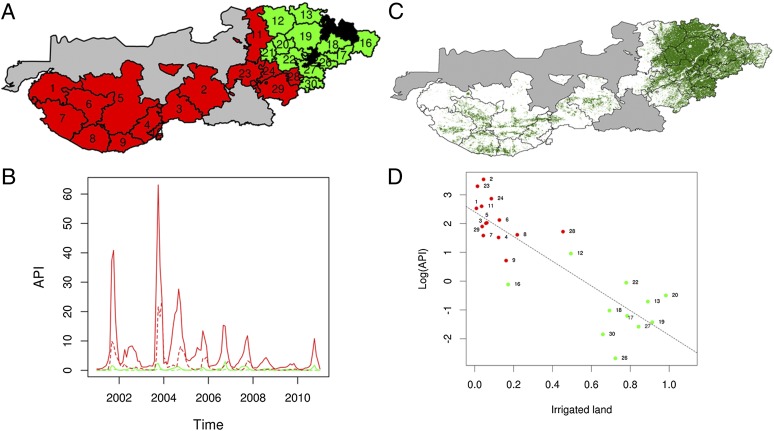Fig. 1.
Spatio-temporal pattern in malaria population dynamics and its relationship to irrigation development. (A) Two groups in the configuration of malaria risk obtained by the Bayesian grouping algorithm. Areas of high risk are colored in red and those of low risk areas, in green. (The overall results on groupings are robust to the choice of parasite species, as well as to the number of levels for the different quintile divisions of the epidemiological data). (B) The time series of accumulated cases are shown for the two groups (red and green) and for the two malaria species (solid line, P. vivax and dashed line, P. falciparum). Most of the malaria burden in the region corresponds to P. vivax. For comparison with A, C shows the irrigation pattern for the year 2009, for which a detailed irrigation map was available. This comparison shows that the high and low malaria groups map respectively onto the non- (or low-) irrigated (in white) and irrigated areas (in green) respectively. Although the map is for 2009, a similar broad pattern of irrigation holds across years (SI Appendix, Fig. S8), and the eastern region has been irrigated for at least three decades (SI Appendix, Fig. S2). The detailed pattern of how irrigation has changed in the more recent decade is addressed in Fig. 2. (D) An example of the malaria–irrigation relationship for the large epidemic of the year 2003. In this plot, each point corresponds to Annual Parasite Incidence (API, cases per 1,000 people) in log scale in a particular taluka, during the epidemic season (September–December), as a function of the proportion of the land classified as irrigated, based on January’s vegetation from remote sensing (Methods). The numbers in A and D correspond to the name of a taluka as follows: 1, Lakhpat; 2, Rapar; 3, Bhachau; 4, Anjar and Gandihan; 5, Bhuj; 6, Nakhatrana; 7, Abdasa; 8, Mandavi; 9, Mundra; 11, Cac; 12, Tharad; 13, Dhanera; 16, Danta; 17, Vadgam; 18, Palanpur; 19, Deesa; 20, Deodar; 21, Bhabhar; 22, Kankrej; 23, Santalpur; 24, Radhanpur; 26, Sidhpur; 27, Patan; 28, Harij; 29, Sami; and 30, Chanasma.

